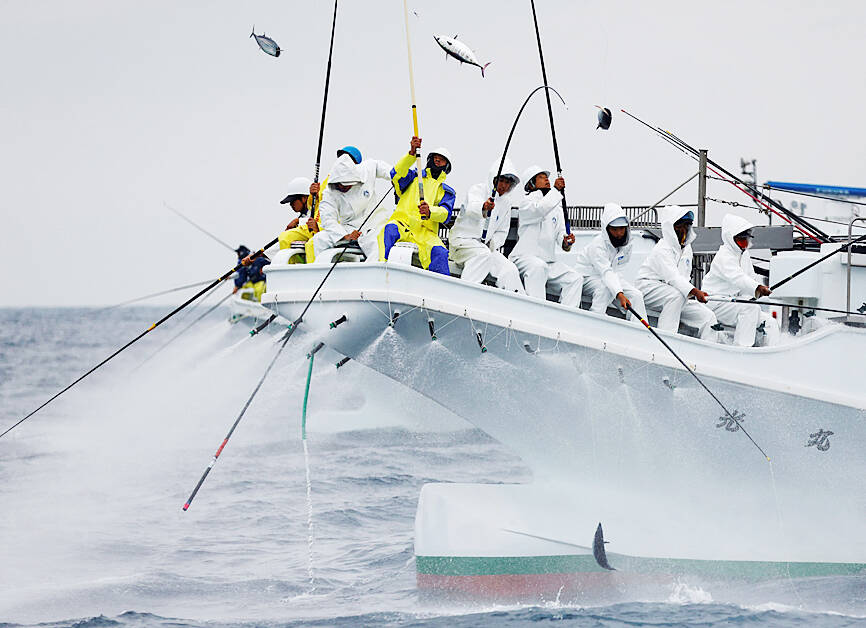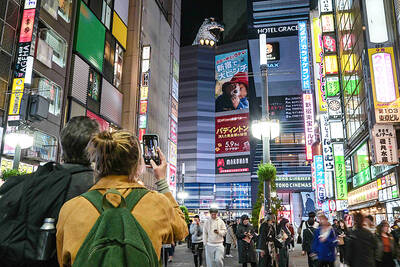There is little at Shiogama seafood market to suggest that Japanese consumers could one day be deprived of their favorite seafood — from giant crab’s legs simmering in a winter nabe hot pot to spheres of salmon roe resting on a bed of rice wrapped in nori seaweed.
Stalls heave with huge sides of bluefin tuna, expertly transformed into more manageable portions by knife-wielding workers, while early-morning shoppers pause to inspect boxes of squid, flounder and sea pineapples landed only hours earlier.
Despite the bounty on display in this small port town, a growing body of scientific evidence — backed up by anecdotes from fishers — points to a bleak future for Japanese cuisine as a result of the climate emergency.

Photo: Reuters
Miki Seino, a Shiogama stallholder, flashes a look of weary recognition when a reporter points at her display of sanma — or Pacific saury — an autumn delicacy in Japan, where it is often served grilled or raw as sushi and sashimi.
“The catches are smaller, and the fish are thinner than they were a few years ago. We have heard about how rising sea temperatures are affecting catches here in Tohoku,” said Seino, referring to the region in northeast Japan. “And they are a lot more expensive now.”
The Japanese Fisheries Agency has cited changes in the marine environment due to global heating as the cause of smaller catches of saury, as well as squid, salmon and other staples of the Japanese diet.
The emergence of warm water masses in the Kuroshio — a warm northeasterly ocean current off the east coast — has pushed saury’s spawning migratory path further offshore, where food is less plentiful, resulting in depleted stocks and poorer quality fish.
Aiko Yamauchi, vice president of Seafood Legacy, a Japan-based consulting firm that supports sustainable seafood businesses and environmental groups, said that catches of species venerated by Japanese have been in steep decline since 2014.
It is possible “that other fish species will experience poor catches similar to or worse than at present,” Yamauchi said. “We are very concerned that if this happens, the majority of Japanese fisheries, which supply around half of the country’s seafood, will be exposed to serious damage.”
Hundreds of miles southwest of Shiogama, fishing communities in Kochi Prefecture are fretting over large catches of unusually fatty skipjack tuna, a local delicacy often eaten raw.
Kochi’s arc-shaped bay has traditionally been a fertile fishing ground, but bigger fish could be a warning rather than a blessing. The average surface temperature of the bay in winter has risen 2°C over the past four decades — meaning there is more food for the fish.
However, in the long term, warmer waters could spell disaster, preventing mineral-rich water from rising to the surface, resulting in fewer smaller fish to feed on — and fewer skipjack tuna.
Shin-ichi Ito, a professor at the University of Tokyo’s Atmosphere and Ocean Research Institute, said that rising sea temperatures meant some species, including yellowtail and Spanish mackerel, were being found in unusual locations.
“These species are being caught further north than they were 10 years ago, and this could be the result of climate change,” he said, adding that other hardy perennials of Japanese cuisine were under threat, including kelp on the northernmost main island of Hokkaido and seaweed near the mouth of Tokyo Bay used to make nori.
Not even sushi’s pungent accompaniment is safe, experts say.
They say the increasing frequency and severity of storms is destroying wasabi farms, while rising temperatures are threatening farmers’ ability to cultivate the delicate vegetable, which can only grow in water kept at a consistent 10°C-15°C throughout the year.
Salmon, another sushi staple, is also at risk, Ito said.
“Fish are unable to control their own body temperatures ... the only option is for them to migrate northwards,” he said.
Simulations of sea temperature changes suggest that salmon could disappear from the waters around Hokkaido in Japan’s far north in a matter of decades, he added.
“These changes will inevitably affect the Japanese diet as some species disappear, but they also mean we will see more invasive species,” he said.
A future in which crustaceans have disappeared from the menu seems unthinkable, but ocean acidification risks making that a reality. A rise in seawater temperature makes it more difficult for shellfish and crustaceans to form calcium carbonate, adversely affecting the growth of popular seafood such as scallops, clams and oysters, as well as crabs and shrimps.
“Most people can’t grasp how serious these problems are because they feel they will occur far into the future after they are long gone,” Ito said. “What happens in the year 2100 isn’t their problem ... but we are at a tipping point now.”
Jun Hoshikawa has witnessed changes to the local catch firsthand from his home on Yakushima island, a UNESCO world natural heritage site of natural beauty where he has lived for four decades.
He said he is seeing fewer yellowtail, but bigger numbers of fish that used to be found further south.
“The northern shift in habitats is likely to become a wider trend for many marine species as a result of rising sea temperatures,” said Hoshikawa, a former executive director of Greenpeace Japan.
“Unfortunately, most Japanese people haven’t yet noticed the subtle changes in the seafood they’re eating, although I expect that to change in the coming years,” he added.
As mid-morning approaches, Shiogama market is filling up with regular customers and tourists who can mix and match ingredients to create their own kaisen donburi — raw seafood on rice, seasoned with soy sauce and wasabi.
The dish is a celebration of local produce that changes with the passing months.
Seino said she wonders for how long.
“We are selling fish in the autumn and winter that we used to have only in the summer,” she said. “It feels like the seasons don’t matter anymore.”

POLITICAL PRISONERS VS DEPORTEES: Venezuela’s prosecutor’s office slammed the call by El Salvador’s leader, accusing him of crimes against humanity Salvadoran President Nayib Bukele on Sunday proposed carrying out a prisoner swap with Venezuela, suggesting he would exchange Venezuelan deportees from the US his government has kept imprisoned for what he called “political prisoners” in Venezuela. In a post on X, directed at Venezuelan President Nicolas Maduro, Bukele listed off a number of family members of high-level opposition figures in Venezuela, journalists and activists detained during the South American government’s electoral crackdown last year. “The only reason they are imprisoned is for having opposed you and your electoral fraud,” he wrote to Maduro. “However, I want to propose a humanitarian agreement that

ECONOMIC WORRIES: The ruling PAP faces voters amid concerns that the city-state faces the possibility of a recession and job losses amid Washington’s tariffs Singapore yesterday finalized contestants for its general election on Saturday next week, with the ruling People’s Action Party (PAP) fielding 32 new candidates in the biggest refresh of the party that has ruled the city-state since independence in 1965. The move follows a pledge by Singaporean Prime Minister Lawrence Wong (黃循財), who took office last year and assumed the PAP leadership, to “bring in new blood, new ideas and new energy” to steer the country of 6 million people. His latest shake-up beats that of predecessors Lee Hsien Loong (李顯龍) and Goh Chok Tong (吳作棟), who replaced 24 and 11 politicians respectively

Young women standing idly around a park in Tokyo’s west suggest that a giant statue of Godzilla is not the only attraction for a record number of foreign tourists. Their faces lit by the cold glow of their phones, the women lining Okubo Park are evidence that sex tourism has developed as a dark flipside to the bustling Kabukicho nightlife district. Increasing numbers of foreign men are flocking to the area after seeing videos on social media. One of the women said that the area near Kabukicho, where Godzilla rumbles and belches smoke atop a cinema, has become a “real

Archeologists in Peru on Thursday said they found the 5,000-year-old remains of a noblewoman at the sacred city of Caral, revealing the important role played by women in the oldest center of civilization in the Americas. “What has been discovered corresponds to a woman who apparently had elevated status, an elite woman,” archeologist David Palomino said. The mummy was found in Aspero, a sacred site within the city of Caral that was a garbage dump for more than 30 years until becoming an archeological site in the 1990s. Palomino said the carefully preserved remains, dating to 3,000BC, contained skin, part of the